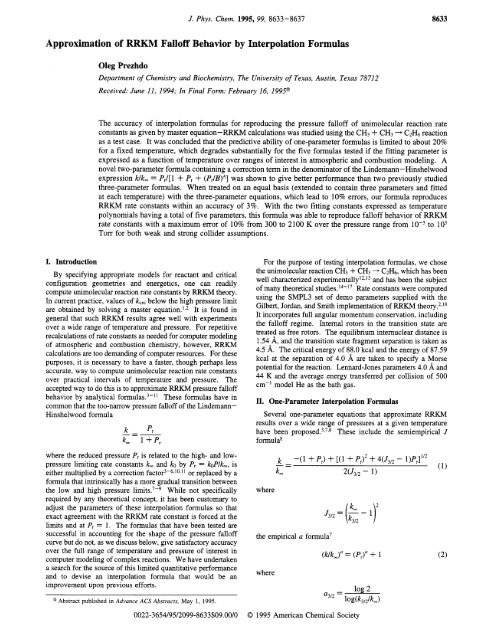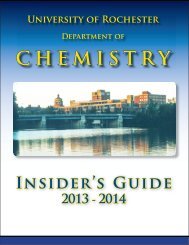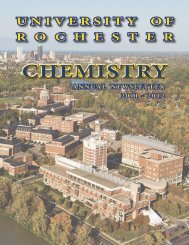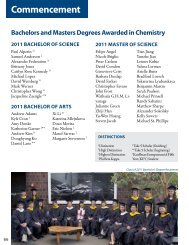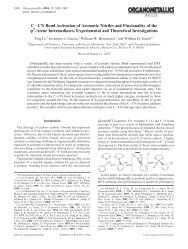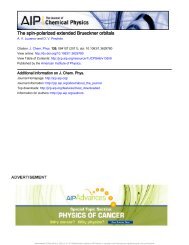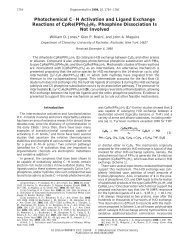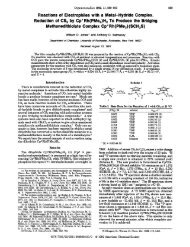Approximation of RRKM Falloff Behavior by Interpolation Formulas
Approximation of RRKM Falloff Behavior by Interpolation Formulas
Approximation of RRKM Falloff Behavior by Interpolation Formulas
Create successful ePaper yourself
Turn your PDF publications into a flip-book with our unique Google optimized e-Paper software.
J. Phys. Chem. 1995, 99, 8633-8637 8633<br />
<strong>Approximation</strong> <strong>of</strong> <strong>RRKM</strong> Fall<strong>of</strong>f <strong>Behavior</strong> <strong>by</strong> <strong>Interpolation</strong> <strong>Formulas</strong><br />
Oleg Prezhdo<br />
Department <strong>of</strong> Chemistry and Biochemistry, The University <strong>of</strong> Texas, Austin, Texas 78712<br />
Received: June 11, 1994; In Final Form: February 16, 1995@<br />
The accuracy <strong>of</strong> interpolation formulas for reproducing the pressure fall<strong>of</strong>f <strong>of</strong> unimolecular reaction rate<br />
constants as given <strong>by</strong> master equation-RRKh4 calculations was studied using the CH3 + CH3 - C2H6 reaction<br />
as a test case. It was concluded that the predictive ability <strong>of</strong> one-parameter formulas is limited to about 20%<br />
for a fixed temperature, which degrades substantially for the five formulas tested if the fitting parameter is<br />
expressed as a function <strong>of</strong> temperature over ranges <strong>of</strong> interest in atmospheric and combustion modeling. A<br />
novel two-parameter formula containing a correction term in the denominator <strong>of</strong> the Lindemann-Hinshelwood<br />
expression klk, = PJ[1 + P, + (P,/B>A] was shown to give better performance than two previously studied<br />
three-parameter formulas. When treated on an equal basis (extended to contain three parameters and fitted<br />
at each temperature) with the three-parameter equations, which lead to 10% errors, our formula reproduces<br />
<strong>RRKM</strong> rate constants within an accuracy <strong>of</strong> 3%. With the two fitting constants expressed as temperature<br />
polynomials having a total <strong>of</strong> five parameters, this formula was able to reproduce fall<strong>of</strong>f behavior <strong>of</strong> <strong>RRKM</strong><br />
rate constants with a maximum error <strong>of</strong> 10% from 300 to 2100 K over the pressure range from to lo5<br />
Torr for both weak and strong collider assumptions.<br />
I. Introduction<br />
By specifying appropriate models for reactant and critical<br />
configuration geometries and energetics, one can readily<br />
compute unimolecular reaction rate constants <strong>by</strong> <strong>RRKM</strong> theory.<br />
In current practice, values <strong>of</strong> kuni below the high pressure limit<br />
are obtained <strong>by</strong> solving a master equation.'s2 It is found in<br />
general that such <strong>RRKM</strong> results agree well with experiments<br />
over a wide range <strong>of</strong> temperature and pressure. For repetitive<br />
recalculations <strong>of</strong> rate constants as needed for computer modeling<br />
<strong>of</strong> atmospheric and combustion chemistry, however, <strong>RRKM</strong><br />
calculations are too demanding <strong>of</strong> computer resources. For these<br />
purposes, it is necessary to have a faster, though perhaps less<br />
accurate, way to compute unimolecular reaction rate constants<br />
over practical intervals <strong>of</strong> temperature and pressure. The<br />
accepted way to do this is to approximate <strong>RRKM</strong> pressure fall<strong>of</strong>f<br />
behavior <strong>by</strong> analytical formulas.3-" These formulas have in<br />
common that the too-narrow pressure fall<strong>of</strong>f <strong>of</strong> the Lindemann-<br />
Hinshelwood formula<br />
where the reduced pressure P, is related to the high- and lowpressure<br />
limiting rate constants k, and k~ <strong>by</strong> P, = koplk,, is<br />
either multiplied <strong>by</strong> a correction fa~tor~-~~'~~"<br />
replaced <strong>by</strong> a<br />
formula that intrinsically has a more gradual transition between<br />
the low and high pressure limit^.^-^ While not specifically<br />
required <strong>by</strong> any theoretical concept, it has been customary to<br />
adjust the parameters <strong>of</strong> these interpolation formulas so that<br />
exact agreement with the <strong>RRKM</strong> rate constant is forced at the<br />
limits and at P, = 1. The formulas that have been tested are<br />
successful in accounting for the shape <strong>of</strong> the pressure fall<strong>of</strong>f<br />
curve but do not, as we discuss below, give satisfactory accuracy<br />
over the full range <strong>of</strong> temperature and pressure <strong>of</strong> interest in<br />
computer modeling <strong>of</strong> complex reactions. We have undertaken<br />
a search for the source <strong>of</strong> this limited quantitative performance<br />
and to devise an interpolation formula that would be an<br />
improvement upon previous efforts.<br />
@ Abstract published in Advance ACS Abstracts, May 1, 1995.<br />
0022-3654/95/2099-8633$09.00/0<br />
For the purpose <strong>of</strong> testing interpolation formulas, we chose<br />
the unimolecular reaction CH3 + CH3 - C2H6, which has been<br />
well characterized e~perimentally'~,'~ and has been the subject<br />
<strong>of</strong> many theoretical studies.I4-l7 Rate constants were computed<br />
using the SMPL3 set <strong>of</strong> demo parameters supplied with the<br />
Gilbert, Jordan, and Smith implementation <strong>of</strong> <strong>RRKM</strong> theory.2s'8<br />
It incorporates full angular momentum conservation, including<br />
the fall<strong>of</strong>f regime. Intemal rotors in the transition state are<br />
treated as free rotors. The equilibrium intemuclear distance is<br />
1.54 A, and the transition state fragment separation is taken as<br />
4.5 8,. The critical energy <strong>of</strong> 88.0 kcal and the energy <strong>of</strong> 87.59<br />
kcal at the separation <strong>of</strong> 4.0 8, are taken to specify a Morse<br />
potential for the reaction. Lennard-Jones parameters 4.0 8, and<br />
44 K and the average energy transferred per collision <strong>of</strong> 500<br />
cm-' model He as the bath gas.<br />
11. One-Parameter <strong>Interpolation</strong> <strong>Formulas</strong><br />
Several one-parameter equations that approximate <strong>RRKM</strong><br />
results over a wide range <strong>of</strong> pressures at a given temperature<br />
have been propo~ed.~.~,~ These include the semiempirical J<br />
formula8<br />
where<br />
the empirical a formula7<br />
where<br />
J3/2 = (2<br />
- 1 )<br />
(klk,)" = (P,)" + 1<br />
log 2<br />
a3/2 =<br />
log(k,,,/k,)<br />
0 1995 American Chemical Society<br />
2
~ (k(J)-k)/k<br />
8634 J. Phys. Chem., Vol. 99, No. 21, 1995<br />
a<br />
0.2 1<br />
0.1 -<br />
-- - (k(a)-k)/k<br />
0.5 c<br />
Prezhdo<br />
/ I<br />
+<br />
Y<br />
=; 0.0 -<br />
Tu<br />
v<br />
-0.1 -<br />
-0.2 -<br />
0.1 -<br />
. .<br />
. . . . . 1(3/2)<br />
J(3/2)/100<br />
\<br />
I a (3/2) I<br />
0<br />
I 1<br />
0 500 1000 1500 2000 2500<br />
T/K<br />
Figure 2. Temperature dependence <strong>of</strong> parameters fitted at P3/2 for five<br />
one-parameter formulas. See text for definitions <strong>of</strong> parameters. The<br />
value <strong>of</strong> a312 is always negative.<br />
1% Fc<br />
log F =<br />
1 + [l0g(P,)l2<br />
where<br />
v Iu<br />
-0.1<br />
-0.2<br />
- -. -.<br />
: -. 1 -** \<br />
-.<br />
-.<br />
*** \<br />
*. -<br />
r<br />
.-. - /<br />
/ ' ".?<br />
I<br />
-0.31 - I<br />
* .-e<br />
-0.4 I' " '<br />
' ' ' " ' ' ' ' I ' ' ' ' ' "<br />
-6 -4 -2 0 2 4 6<br />
I og (P/To rr)<br />
C<br />
0.5 L I<br />
F 0.3 0.4<br />
0.2 I<br />
-0.2 1<br />
'? I<br />
-0.3 t ' ' ' I ' " " ' " ' " ' I ' "<br />
-6 -4 -2 0 2 4 6<br />
I og ( P/To rr)<br />
Figure 1. Relative errors in unimolecular reaction rate constants for<br />
the one-parameter interpolation formulas given <strong>by</strong> eqs 1, 2, 4, and 5<br />
for k(J), 2k(a), 4k(e) and 5k(t), respectively; (a) T = 300 K; (b) T =<br />
1200 K; (c) T = 2100 K. Note that over this temperature range, the<br />
P312 value increases from lo-* to lo4 Torr.<br />
and the empirical F f~rmula~-~<br />
k- F<br />
k, PI + 1<br />
The original form <strong>of</strong> the F formula3 uses the following<br />
expression for F<br />
(3)<br />
F, = 2k3,,Ik,<br />
To give a more accurate result, more advanced versions <strong>of</strong> eqs<br />
2 and 3 have been propo~ed.~-~~'~." These intrinsically manyparameter<br />
equations are considered in the next section.<br />
We investigated two additional one-parameter equations: an<br />
e equation<br />
(klk,)'<br />
and a t equation<br />
ln(e-1)-1<br />
= (1 - e~p[-(P,)~]); e3/2 = lNk3/A)<br />
The one-parameter equations share two attractive features:<br />
they have only a single fitting parameter, which one might hope<br />
could eventually be related to molecular properties, and each<br />
<strong>of</strong> their fitting parameters are determined, at least in the forms<br />
in which they have been described so far, from the rate constant<br />
at a physically meaningful pressure, i.e., at P, = 1, where kOp<br />
= k, and the reaction order is 3/2.<br />
Comparing each <strong>of</strong> these formulas <strong>by</strong> computing rate<br />
constants for the methyl recombination reaction, however,<br />
confiis that they share several disadvantages. First, 20 to 40%<br />
maximum deviations from the RRKh4 results are consistently<br />
observed for each <strong>of</strong> the equations (Figure 1). Second, the<br />
fitting parameters are not simple functions <strong>of</strong> temperature<br />
(Figure 2). Attempting to supplement the one-parameter<br />
pressure fall<strong>of</strong>f formulas with formulas that provide the temperature<br />
dependence <strong>of</strong> the fitting parameters, so as to fit <strong>RRKM</strong><br />
data over both temperature and pressure ranges, increases these<br />
errors. While the one-parameter formulas are more accurate<br />
than the Lindemann-Hinshelwood formula they were introduced<br />
to replace, they are not as accurate as one would wish<br />
when parameterized at P,. = 1 and used over the full pressure<br />
fall<strong>of</strong>f range. It is clearly possible, however, to attain improved<br />
accuracy <strong>by</strong> limiting the pressure and/or temperature range <strong>of</strong><br />
(4)
<strong>Approximation</strong> <strong>of</strong> <strong>RRKM</strong> Fall<strong>of</strong>f <strong>Behavior</strong> J. Phys. Chem., Vol. 99, No. 21, 1995 8635<br />
-<br />
0.10 -<br />
0.05 -<br />
5<br />
f 0.00 1<br />
Y<br />
w<br />
-0.05 -<br />
-0.10 -<br />
r<br />
--<br />
-<br />
-<br />
.........<br />
- 900K<br />
1200K<br />
1500K<br />
- 1800K<br />
2100K<br />
L<br />
I<br />
-0.158-0.15 ~<br />
- 6 - 4 - 2 0 2 4 6 8<br />
I og (P/To rr)<br />
0.10 -<br />
0.05 -<br />
Y<br />
2<br />
0.00 L<br />
w<br />
-0.05 -<br />
-0.10 -<br />
--<br />
-6 -4 -2 0 2 4 6<br />
log(P/Torr)<br />
- 900K<br />
- 1200K<br />
1500K<br />
- - 1800K<br />
......... 21 OOK<br />
8<br />
0.4<br />
h<br />
Y<br />
1.5<br />
0.3<br />
1.4<br />
-0.2<br />
2<br />
'D 0.2<br />
0'<br />
0.1<br />
1.3 2<br />
1.2<br />
m<br />
r<br />
(1<br />
3<br />
-0.4<br />
\<br />
\<br />
\<br />
\<br />
A\<br />
\<br />
\<br />
v,<br />
In<br />
1.8 2<br />
I I 1 1<br />
0.0 I ' 1.1<br />
0 1000 2000<br />
TIK<br />
C<br />
0.4 1.5<br />
*C<br />
- -+ -d<br />
0.3<br />
TJ 0.2<br />
0'<br />
0.1<br />
-t<br />
b ..................<br />
-<br />
-<br />
L<br />
i-<br />
-<br />
N<br />
..._e...<br />
0.0 I 1 I I I 11.1<br />
-0.6 -0.5 -0.4<br />
log(Fc)<br />
Figure 3. (a) Relative errors in rate constants for eq 6 with parameters<br />
fitted at each temperature; (b) temperature dependence <strong>of</strong> parameters<br />
<strong>of</strong> eq 6; (c) parameters <strong>of</strong> eq 6 as functions <strong>of</strong> log F,, originally proposed<br />
relationships (ref 3 c = -0.4 - 0.67 log F,, N = 0.75 - 1.27 log F,,<br />
d = 0.14, and correlations from ref 10 proposed c = -0.2 - 1.31 log<br />
Fc, N = 0.87 - 0.74 log Fc. d = 0.048.<br />
application and setting the fitting parameter to optimize the<br />
fitting accuracy in that range.<br />
111. Many-Parameter <strong>Formulas</strong><br />
<strong>Formulas</strong> with more than one parameter can do a better job<br />
fitting <strong>RRKM</strong> pressure fall<strong>of</strong>f data.<br />
1.6<br />
-0.6<br />
0 1000 2000<br />
T/K<br />
Figure 4. (a) Relative errors for eq 7 with parameters fitted at each<br />
temperature; (b) temperature dependence <strong>of</strong> parameters in eq 7.<br />
Several many-parameter extensions <strong>of</strong> the F equation (3) have<br />
been proposed. The earliest was an extension <strong>of</strong> the F formula<br />
itself to give it the Lorentzian fom3-5<br />
log F =<br />
1% Fc<br />
1 + [(log P, + c)/(N - d[log P, + C1)l2<br />
F,, N, d, and c being parameters and the latest being the<br />
Gaussian form'O<br />
F,, a, and u being parameters.<br />
Applied to the same set <strong>of</strong> data with all parameters fitted at<br />
each temperature, these formulas show maximum deviations <strong>of</strong><br />
about 10% (Figures 3a and 4a, respectively). The temperature<br />
dependence <strong>of</strong> the parameters, however, is again quite complex<br />
(Figures 3b and 4b). Thus, errors will increase if the parameters<br />
are fitted <strong>by</strong> functions <strong>of</strong> temperature.<br />
Originally, the parameters in eq 6 were correlated with log<br />
F,. It was claimed that once these correlations were established<br />
they could be applied uni~ersally.~-~ The parameters in eq 6<br />
are plotted as functions <strong>of</strong> log F, in Figure 3c. Neither the<br />
original relationship^^-^ nor the later oneslo describe the data<br />
for the methyl recombination reaction. From the data displayed,<br />
one has to conclude that it seems unlikely that universal<br />
(6)
8636 J. Phys. Chem., Vol. 99, No. 21, 1995<br />
Prezhdo<br />
0.037<br />
----_ 300K<br />
0.02<br />
-<br />
0.01<br />
5 0.00<br />
e<br />
-0.01<br />
-0.02<br />
-<br />
-<br />
-<br />
-<br />
-0.06 r* " I " ' I " ' " ' I ' ' ' I " ' ' ' ' I ' I<br />
- 6 - 4 - 2 0 2 4 6 8<br />
log( P/Torr)<br />
Figure 5. Relative errors for eq 8 with the parameters a and b fitted<br />
at each temperature.<br />
expressions for the parameters in eq 6 exist; they must depend<br />
on the reaction under study.<br />
The limited accuracy achieved with eqs 6 and 7 led us to<br />
search for alternative many-parameter interpolation formulas.<br />
The most successful <strong>of</strong> the ones we studied turned out to have<br />
but two fitting parameters. It nonetheless outperformed both<br />
eqs 6 and 7.<br />
Equations 6 and 7 exploit the idea <strong>of</strong> multiplying the<br />
Lindemann-Hinshelwood fall<strong>of</strong>f expression <strong>by</strong> a broadening<br />
factor <strong>of</strong> either a Lorentzian (eq 6) or a Gaussian (eq 7) type.<br />
In our approach, we also used the Lindemann-Hinshelwood<br />
formula as a starting point. We eventually found that, instead<br />
<strong>of</strong> multiplying it <strong>by</strong> a factor, a better result could be obtained<br />
<strong>by</strong> adding a two-parameter modification term to its denominator:<br />
-_ k- pr<br />
k- 1 + P, + (PjB)A'<br />
. O
<strong>Approximation</strong> <strong>of</strong> <strong>RRKM</strong> Fall<strong>of</strong>f <strong>Behavior</strong><br />
0.10 1<br />
0.05<br />
0.00<br />
-0.05<br />
-<br />
-<br />
-<br />
\ f<br />
-0.10 -<br />
d<br />
,.<br />
--<br />
. . m y *<br />
I t ,I . --<br />
. I<br />
- 600K<br />
- 900K<br />
1200K<br />
1500K<br />
1800K<br />
- 21 OOK<br />
0'157<br />
0.10 -<br />
0.05<br />
5<br />
y 0.00<br />
z<br />
-0.05<br />
-0.10<br />
-<br />
-<br />
-<br />
-<br />
-<br />
-..._<br />
--<br />
. . . . . -.<br />
- 6 - 4 - 2 0 2 4 6 8<br />
log( Pnorr)<br />
Figure 9. Relative errors for eq 8 with the parameters a and b<br />
expressed as functions <strong>of</strong> temperature <strong>by</strong> second- and first-order<br />
polynomials. A strong collider model was used for the <strong>RRKM</strong><br />
calculations.<br />
tially different conditions (Figure 9). Thus, given high- and<br />
low-pressure limiting rate constants as well as five empirical<br />
values, which define the parameters a and b as functions <strong>of</strong><br />
temperature (Figure 7), eq 8 is able to reproduce <strong>RRKM</strong> fall<strong>of</strong>f<br />
results over a wide range <strong>of</strong> pressure (10-5-105 Torr) and<br />
temperature (300-2100 K) with maximum errors <strong>of</strong> about lo%,<br />
substantially less than the expected systematic errors <strong>of</strong> the<br />
corresponding experimental measurements.<br />
Equation 8 can be tested directly against experimental data.<br />
Reference 13 provides measured rate constants for methylmethyl<br />
recombination from 296 to 906 K. We took the values<br />
<strong>of</strong> the high- and low-pressure limiting rate constants suggested<br />
in ref 15 and applied eq 8 to the data in ref 13 at two<br />
representative temperatures for which a substantial part <strong>of</strong> the<br />
fall<strong>of</strong>f region was covered (Figure 10). Equation 8 describes<br />
the experiments as well as more detailed RRKh4 ~alculations.'~<br />
In both cases, the fitting accuracy is mainly determined <strong>by</strong> the<br />
quality <strong>of</strong> the experimental data.<br />
IV. Conclusions<br />
<strong>Interpolation</strong> formulas describing the pressure fall<strong>of</strong>f <strong>of</strong><br />
unimolecular reaction rate constants computed <strong>by</strong> an RRKh4-<br />
master equation program for the reaction CH3 + CH3 - C2H6<br />
were compared for accuracy over the temperature range 300 to<br />
J. Phys. Chem., Vol. 99, No. 21, 1995 8637<br />
A 577K; data Of [13]<br />
v 906K; same<br />
-0- 577K; <strong>RRKM</strong> [ 151<br />
---O--- 906K; same<br />
- - 577K; Troe eq (151<br />
--- 906K: same<br />
7<br />
577K; eq (8)<br />
t :'<br />
-906K; same I<br />
l....~:~....~....~...'1....1....1....1....~<br />
0 1 2 3 4<br />
log( P/Torr)<br />
Figure 10. Methyl-methyl recombination experimental rate constant^'^<br />
fitted <strong>by</strong> eq 8 together with the <strong>RRKM</strong> data and analytical fits to the<br />
Troe formula (6).IJ The constants <strong>of</strong> eq 8 were a = 0.51, b = -2.41<br />
at 577 K and 0.40 and -1.43 at 906 K.<br />
2100 K for pressures from to lo5 Torr. It was found that<br />
the best performance was obtained for a new interpolation<br />
equation in which a two-parameter correction is added to the<br />
denominator <strong>of</strong> the Lindemann-Hinshelwood fall<strong>of</strong>f formula.<br />
Acknowledgment. This research was sponsored <strong>by</strong> the Gas<br />
Research Institute. We acknowledge fruitful discussions with<br />
W. C. Gardiner, A. F. Wagner, and I. Oref and thank M.<br />
Frenklach for providing copies <strong>of</strong> refs 10 and 11 in advance <strong>of</strong><br />
publication.<br />
References and Notes<br />
(1) Oref, I.; Tardy, D. C. Chem. Rev. 1990, 90, 1407.<br />
(2) Gilbert, R. G.; Smith, S. C. Theory <strong>of</strong> Unimolecular and Recombination<br />
Reactions; Blackwell Scientific Publications: Oxford (UK) and<br />
Cambridge (MA), 1990.<br />
(3) Troe, J. J. Phys. Chem. 1979, 83, 114.<br />
(4) Troe. J. Ber. Bunsen-Ges. Phvs. Chem. 1983. 87. 101.<br />
(5) Gilbert, R. G.; Luther, K.; Troe, J. Ber. Bunsen-Ges. Phys. Chem.<br />
1983, 87, 169.<br />
(6) Gardiner, W. C., Jr.; Troe, J. In Combustion Chemistry; Gardiner,<br />
W. C., Jr., Ed.; Springer-Verlag: Berlin, 1984; Chapter 4.<br />
(7) Gardiner, W. C., Jr. Proceedings <strong>of</strong> the 12th IMACS World<br />
Congress on Scientific Computations; Vichnevetsky, R., Borne, P., Vignes,<br />
J., Eds.; IMACS: Paris, 1988; p 582.<br />
(8) Oref, I. J. Phys. Chem. 1989, 93, 3465.<br />
(9) Pawlowska, 2.; Gardiner, W. C.; Oref. I. J. Phys. Chem. 1993, 97,<br />
5024.<br />
(10) Wang, H.; Frenklach, M. Chem. Phys. Lett. 1993, 205, 271.<br />
(11) Kazakov, A.; Wang, H.; Frenklach, M. J. Phys. Chem. 1994, 98,<br />
10598.<br />
(12) Mallard, W. G.; Westley, F.; Herron, J. T.; Hampson, R. F.; Frizzell,<br />
D. H. NIST Chemical Kinetics Database: Version 5.0; National Institutz <strong>of</strong><br />
Standards and Technology: Gaithersburg, MD, 1993.<br />
(13) Slagle, I. R.; Gitman, D.: DavGs. J. W.; Pilling, M. J. J, Phys.<br />
Chem. 1988, 92, 2455.<br />
(14) Walter, D.; Grotheer, H. H.; Davies. J. W.; Pilline. M. J.: Wagner.<br />
A. F. In Twenty-Third Symposium (International) on Eombustion:-The<br />
Combustion Institute: 1990; pp 107-1 14.<br />
(15) Wagner, A. F.; Wardlaw, D. M. J. Phys. Chem. 1988, 92, 2462.<br />
(16) Wardlow, D. M.; Marcus, R. A. Chem. Phys. Lett. 1984,110, 230.<br />
(17) Stewart, P. H.; Larson, C. W.; Golden, D. M. Combust. Flame 1989,<br />
75, 25.<br />
(18) Program Unimol Gilbert, R. G.; Jordan, M. J. T.; Smith, S. C. 1990,<br />
Department <strong>of</strong> Theoretical Chemistry, Sydney University, NSW 2006,<br />
Australia. The data set we used is the demo provided as SMPL3 in the<br />
distribution. It was found that convergence to the high pressure limit was<br />
not obtained automatically <strong>by</strong> the program. The klk, values used for our<br />
analysis were obtained <strong>by</strong> multiplying the klk, values computed <strong>by</strong> the<br />
MASTER program <strong>by</strong> the ratio <strong>of</strong> the output k, value to the kun, value<br />
computed bjt the program at P = 10'O Torr. The full array <strong>of</strong> fall<strong>of</strong>f data<br />
used in our work can be obtained over the Internet <strong>by</strong> anonymous ftp; log<br />
in to lioness.cm.utexas.edu and grab (or get) the ASCII text file methyl-<br />
.fall<strong>of</strong>f in the directory /pub/Fall<strong>of</strong>fdata.<br />
JP94 1430C


